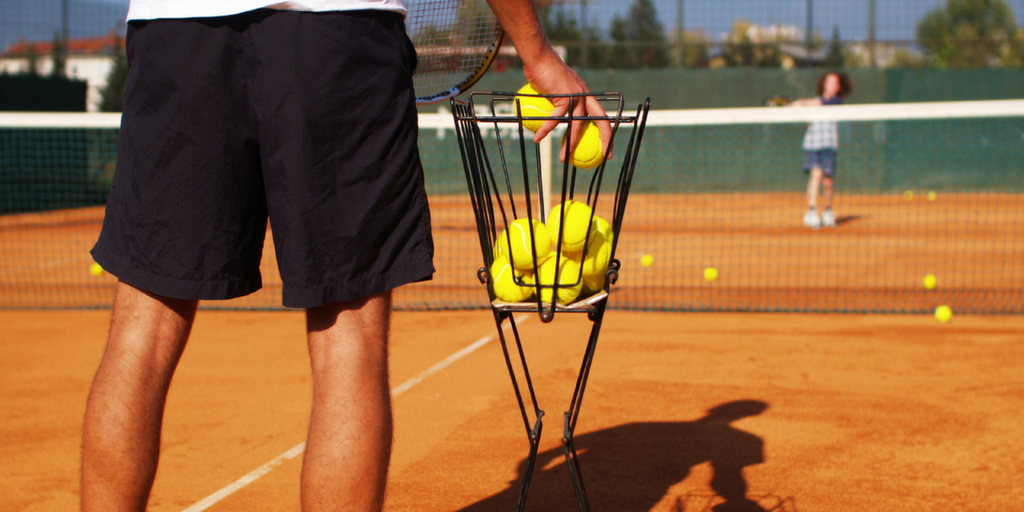Last week I asked a group of my younger players to do a drill incorporating slice backhands. We began with some hand-feeding of balls to their usually-mediocre slices. Yet they had all been working on slicing over the past months, and some progress was becoming evident. "Not bad," I said to myself. Time for live ball. "Hit a serve, return, four crosscourt slices,” I told them, “and then the point goes open.” Twelve minutes into the drill the kids were working exceptionally hard, but no one had yet made it through the first six shots. Balls were skipping off the edges of racquets, skidding onto the adjacent courts. (A few veterans on the next court harumphed a bit.) I started feeling slightly nauseous. Bing! The image of a Swifter cleanup cloth pinged my mind, quickly followed by a mop and pail. (Where is that bald Shark Vaccum guy when you need him?) What an effing mess! I pull my hood up. Slightly embarrassed, I check to see if the parents are witnessing this sloppy chaos through the newly Windexed glass at the club. If only it were still dirty.
"We coaches all love controlled topspin hitting, the comfort food of tennis academies."

"The road to mastery and winning at the highest levels is never clean. It is always dirty."
The problem, unfortunately, is that sports are not art. Young Johnny never learns to struggle—and never learns to slice in a realistic setting. And the coach never figures out to help Johnny master the slice. On a national scale, this results in a lot of good drillers with a limited set of skills—but very few good players. The road to mastery and winning at the highest levels is never clean. It is always dirty. Learning technique, learning movement, learning to play is mentally arduous, full of turmoil. There are fits, starts, and spins, dogged by unease, anger, and humiliation. (Why else would our breakthroughs bring such elation?)
"As long as your athletes are working hard, let them struggle."
So, some advice to coaches: as long as your athletes are working hard, let them struggle. Stay away from keeping everything so clean, tidy, and controlled. Furthermore, visit them in the place of struggle. Realize you may be uncomfortable as well. Its may look like a mess, but over time it will take shape. Try to figure it out. Get mad at yourself. Use your angry energy to learn. Does this mean we’ll accept crappy technique and movement? Certainly not. Demand the best, but know it won’t happen in a minute, a week, or perhaps even a year. Keep a few things in mind.
1. Know your stuff. Understand how to teach the shots you expect your players to learn as well as possible. If you don't know, figure it out. Ask for help. Coaches need their own coaches, too.
2. Teach in progressions, but allow plenty of time for live ball drills, preferably ones starting with a serve. Feeding balls starts them on the road to mastery, but a stroke is not a shot. Learning to split-step, and react may be the most difficult skill they have to learn. Too much feeding doesn't allow for that skill building.
3. Force the players to split-step just as if they were playing a point. Have them act like they need to cover the whole court. Demand that they run after everything, and don't accept it when they whine, telling their partner, "You are supposed to hit it there."
4. Stay away from too many cooperative drills. Instead, do competitive drills. The goal is to figure out how to use certain shots to win points. (Yes, and it’s OK if kids lose. In real competition, that happens. A lot.)
5. Consistently work on one shot, other than topspin groundstrokes, in a live ball setting over the course of weeks or months. Again, a shot and a stroke are different. They must learn to react and move to the ball! Learn to tend to the mess, and to sculpt excellence from it. Relish the fact that tennis’s top developmental coaches are just as good, and at least as important, as the ones who work with the world's top pros.
In his earlier essay, “I’m Not FEELIN’” It Today!,” Tim Mayotte delved into the problems that arise when tennis players focus too much on their emotions in practices or matches. Tim Mayotte, a former top-ten player on the ATP tour, is a New England native who now coaches high-performance juniors in the Boston area. He is now writing a book titled, The Framework: A New Paradigm in Teaching Technique and Movement.


